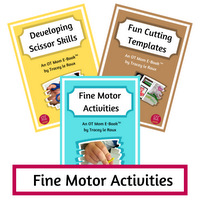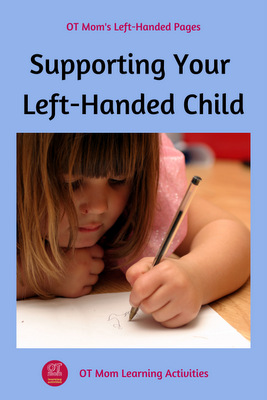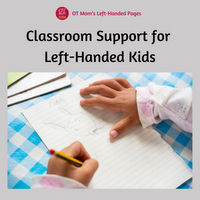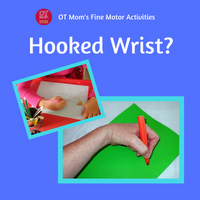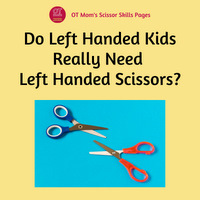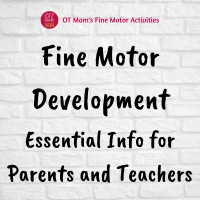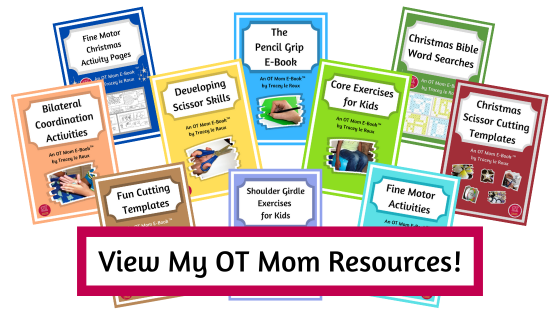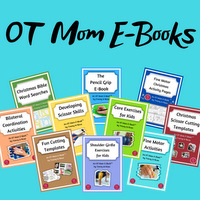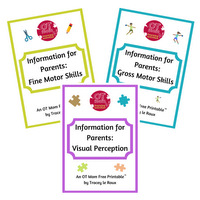- Home Page
- Skills For A Left-Handed Child
Skills For A Left-Handed Child
Are you a right-handed parent of a left-hander? Do you know how to support the development of skills for a left-handed child? Do you wonder what left-handed children struggle with? A few parents have asked me these questions!
I sometimes link to products (#Ad) that are similar to those I use and love. If you do purchase something through my links, I will receive a small commission that helps support my site - thank you!
Being left-handed is perfectly normal and not a disadvantage at all. However, since most of the world is geared to right-handers, there are a few key areas where having a lefty-specific approach can make a big difference to your child.
On this page, we will look at how to support all the foundational skills for a left-handed child, from strong hand muscles, to writing without smudging.

This is a hub page which will send you out to more detailed articles on my site if you want to dig deeper.
Key Takeaways For Busy Parents:
- Get Hands-On: give your child lots of opportunities to use their left hand for hands-on fine motor activities every day - this will improve their hand strength and fine motor skills.
- Use Left-Handed Scissors: True left-handed scissors help your child to cut neatly on the line and strengthens hand muscles.
- Don't Force A Pencil Grip: A child's pencil grip develops in stages. Focus on fine motor skills rather than forcing a "proper" pencil grip before they are ready.
- Paper Position Is Important: Help your lefty write more easily with this tip: position the paper to the left of the body and tilt the paper clockwise so the top left corner is slightly up.
Quick Navigation On This Page:
- What fine motor skills activities are good for a left-handed child?
- How to teach a left-handed child to cut with scissors?
- Best pencil grip for a left-handed kid?
- Left-Handed Handwriting
- Left Hand Writing Position
- Teaching Left-Handed Writing - Resources for Lefties
What Fine Motor Skills Activities Are Good For A Left-Handed Child?
The more a left-handed child uses their left hand in fine motor activities, the more skilled the hand and finger muscles will become.
Parents and teachers should make sure that lefties are using their left hands when using fine motor tools such as tweezers, tongs and paintbrushes, to get as much practice as possible.
This may seem obvious, but often kids will mimic what they see and might use the same hand as the teacher or parent! So keep an eye on which hand is being used!
 Painting with the left hand
Painting with the left handAll of the fine motor activities on my website are applicable to left-handed kids as well as right-handed kids, and have photos and lots of tips, so pop on over and get some easy ideas to do at home:
- toddler fine motor activities
- fine motor activities for preschool and kindergarten
- finger exercises
- fine motor activities with playdough
- pencil control activities
How To Teach A Left-Handed Child To Cut With Scissors?
Scissor cutting is an important fine motor skill, because it develops the muscles of the hand that are used for controlling a pencil.
Your left-handed child needs to cut with
the left hand, using left-handed scissors, in order to get these important fine
motor benefits!
 Cutting with the left hand
Cutting with the left handAll the basic principles of scissor cutting apply to left-handed kids - they need to:
- master the grasp-release motion
- learn to cut along a line
- and get lots and lots of practice in cutting out simple shapes.
- Read more about why left-handed scissors are a thing!
- Check out my answers to questions parents have had about left-handed scissors
- You can get lefty scissors on Amazon#Ad and in most stationery stores
Is There A Left-Handed Pencil Grip?
Do left-handed kids need to hold the pencil in a special way? The short answer is no, they don't!
Lefties need to get the same functionality from a pencil grip as a right-handed child. That means we want them to be able to write legibly, comfortably and without getting tired.
For both left- and right-handed kids, the tripod pencil grip (with the thumb, index and middle fingers on the pencil, as shown here), is described as an ideal grip. This pencil grip enables the fingers to move freely.
However, there are a number of slight adaptations that are still efficient and functional for both left-and right-handed kids - pop on over and view photos of different pencil grasps that might work for your child.
But please remember that your young lefty should not be forced to hold the pencil with three fingers - they need to move through the different stages of normal pencil grasp development as their fine motor skills improve.
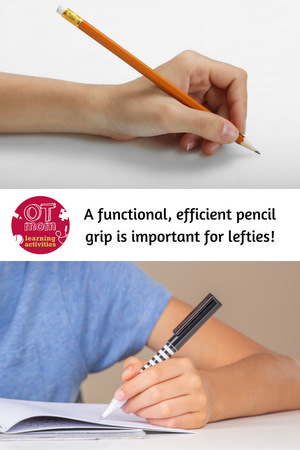
If your child tires easily when holding a pencil, you can:
- try some simple hand strengthening activities before writing
- consider the use of a pencil grip for comfort
- try specially designed Penagain pencils#Ad, or ergonomically designed left-handed pens#Ad to help your child sustain a functional pencil grasp.
Left-Handed Handwriting
The same pencil grasps that work well for right-handed kids will work for left-handed kids.
But the left-handed handwriting challenges that many your child may face, come from these main issues:
- right-handers naturally use a *pulling* motion in order to write, which is easier than the *pushing* motion that left-handers need to use.
- left-handed kids often struggle to see what they are writing, and the writing can get smudged by their hands.
- a common solution is to hook the wrist in order to see the written work and to pull the pen along the page. However this is a tiring and inefficient way to write.
Let's take a look at how we can help address these handwriting challenges that lefties might face:
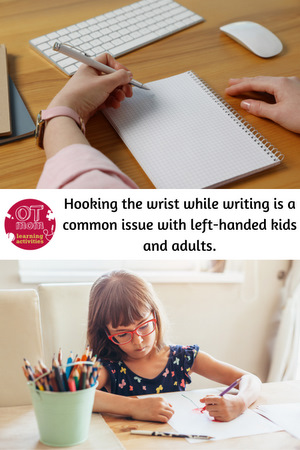
- Left Hand Writing Position
The “hooked” wrist that many left-handers use, stops the fingers from moving freely, which means the child often uses wrist movements to form letters, instead of using finger movements.
It is therefore a more tiring and less efficient way to write!
What Is The Best Writing Position For Lefties?
The best writing position for lefties, is to position the paper slightly to the left of the body, and then tilt the paper slightly to the right (clockwise), as shown.
The left corner of the paper will then be slightly higher.
This can help your child to:
- see what they are writing as they write
- prevent smudging
- maintain a functional pencil grip
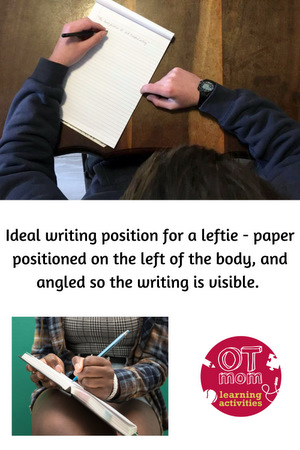
If your child has been writing with a hooked wrist for some time, they may find this position a bit uncomfortable at first.
- Try some wrist extension exercises to help stretch tight wrist muscles.
- How To Teach A Left-Handed Child To Write
It feels more natural to reverse letters and to work from right to left if you are a lefty. It helps to be aware of this, and you may need to spend more time reinforcing the correct letter formations.
Suggestions for teaching left-handed writing:
- Use my letter formation tips for simple ideas to help kids master letter formations.
- Try Handwriting Heroes, which is a fantastic program teaching letter formations and handwriting in a multi-sensory way - effective for both left- and right-handers.
- Positioning the paper more effectively for writing will help a lefty to see their work better, which makes it easier for them to work from left to right.
- To help your child to work from left to right across the page, it may help to draw an arrow at the top of each handwriting page, or to put an arrow on the desk.
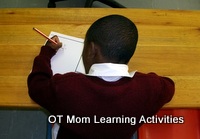 Best position for left-handed handwriting
Best position for left-handed handwritingHelpful Resources To Build Skills For A Left-handed Child
- OT Mom's Fine Motor Resources - a plethora of hand exercises, finger skills and much more!
- OT Mom's Scissor Cutting Guide - everything you need improve scissor skills for a left-handed child as well as right!
- Your Left-Handed Child by Lauren Milsom
- If your child is already in formal schooling, check out my recommended classroom accommodations for left-handed students.
By focusing on these foundation skills for a left-handed child, you are giving your child the best chance at success!
You have taken steps to understand and support your left-handed child in a right-handed world, and this will help them grow in confidence and enjoy the learning process.
The next step is to make sure your child is supported as they progress through school and take on new learning experiences in different environments.
To see what simple changes can make a big impact, read my related page on Classroom Support for Left Handed Kids.
Please do consult your health professional if you are in any way concerned about your child’s development as a left-hander!
- Home Page
- Skills For A Left-Handed Child
Share this page to help others!
Related Pages
Didn't find what you were looking for? Try a search of my site!
